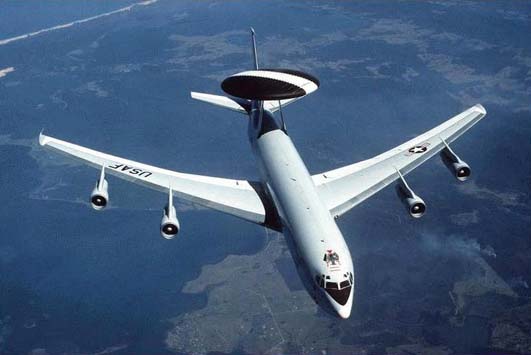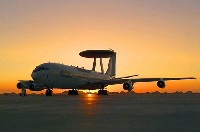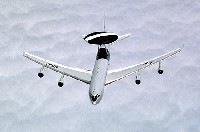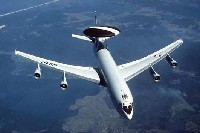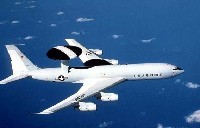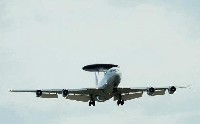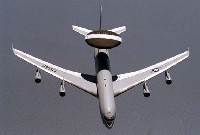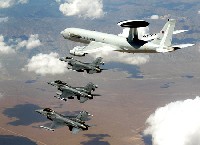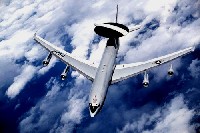|
Global Aircraft -- E-3 Sentry
Aviation Center
US Attack
US Bombers
US Cargo
US Fighters
US Helicopters
US Patrol/Pursuit
US Reconnaissance
US Tankers
US Trainers
US UAV's
US X Planes
Orbiter Vehicles
WWI Aircraft
WWII Aircraft
Airbus
Antonov
Boeing
Dassault
Ilyushin
Kamov
MiG
Mil
Saab
Sukhoi
Tupolev
Yakovlev
Joint/Rest of World
Entertainment Center
Members Center
New Technologies
Contact Us
Extra Navigation
GAC Engine
E-3 Sentry Specifications
E-3 Sentry Features
The E-3 Sentry is a modified Boeing 707/320 commercial airframe with a rotating radar dome. The dome is 30 feet (9.1 meters) in diameter, six feet (1.8 meters) thick, and is held 14 feet (4.2 meters) above the fuselage by two struts. It contains a radar subsystem that permits surveillance from the Earth's surface up into the stratosphere, over land or water. The radar has a range of more than 250 miles (375.5 kilometers) for low-flying targets and farther for aerospace vehicles flying at medium to high altitudes. The radar combined with an identification friend or foe subsystem can look down to detect, identify and track enemy and friendly low-flying aircraft by eliminating ground clutter returns that confuse other radar systems. The E-3 fleet will complete its largest upgrade in 2001. Known as the Block 30/35 Modification Program, the upgrade includes four enhancements:
- Electronic Support Measure for passive detection, an electronic surveillance capability to detect and identify air and surface-based emitters. Other major subsystems in the E-3 are navigation, communications and computers (data processing). Consoles display computer-processed data in graphic and tabular format on video screens. Console operators perform surveillance, identification, weapons control, battle management and communications functions. The radar and computer subsystems on the E-3 Sentry can gather and present broad and detailed battlefield information. Data is collected as events occur. This includes position and tracking information on enemy aircraft and ships, and location and status of friendly aircraft and naval vessels. The information can be sent to major command and control centers in rear areas or aboard ships. In time of crisis, this data can be forwarded to the president and secretary of defense in the United States. In support of air-to-ground operations, the Sentry can provide direct information needed for interdiction, reconnaissance, airlift and close-air support for friendly ground forces. It can also provide information for commanders of air operations to gain and maintain control of the air battle. As an air defense system, E-3s can detect, identify and track airborne enemy forces far from the boundaries of the United States or NATO countries. It can direct fighter-interceptor aircraft to these enemy targets. Experience has proven that the E-3 Sentry can respond quickly and effectively to a crisis and support worldwide military deployment operations. It is a jam-resistant system that has performed missions while experiencing heavy electronic countermeasures. With its mobility as an airborne warning and control system, the Sentry has an greater chance of surviving in warfare than a fixed, ground-based radar system. Among other things, the flight path can quickly be changed according to mission and survival requirements. The E-3 can fly a mission profile for more than 8 hours without refueling. Its range and on-station time can be increased through inflight refueling and the use of an on-board crew rest area. The aircraft are used as a surveillance asset in support of counter drug missions. U.S. Customs Service officers may fly aboard the E-3 Sentry on precoordinated missions to detect smuggling activities. Source: http://www.af.mil
E-3 Sentry Background
The Boeing E-3 Sentry is the West's principal AWACS platform. The EC-137D prototype first flew on February 5, 1972, followed by the E-3A first flight on October 31, 1975. The E-3A uses the 707-320B airframe and a massive payload of radar and electronic sensors. The E-3 can scan the skies of all aircraft and missiles and report what it sees electronically to all friendly aircraft, ground fleet, satellites, and to any main headquarter bases. The E-3 is exported to many different countries including France, NATO, Saudi Arabia, and UK. France operates 4 E-3F, Saudi Arabia operates about 5 E-3A, the UK operates around 7 Sentry aircraft, NATO operates about 18 E-3A, and the USAF operates about 32 E-3. Summary Copyright © Charles M (JetWhiz) | ||||||||||||||||||||||||||||||||||||||
